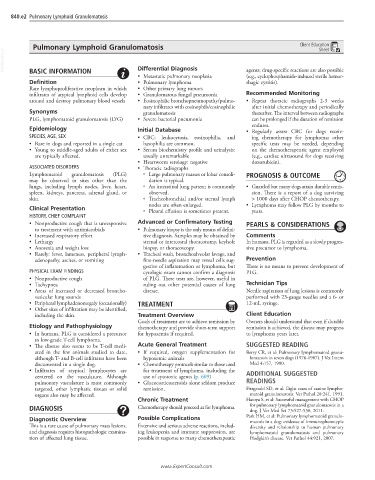Page 1674 - Cote clinical veterinary advisor dogs and cats 4th
P. 1674
840.e2 Pulmonary Lymphoid Granulomatosis
Pulmonary Lymphoid Granulomatosis Client Education
Sheet
VetBooks.ir Differential Diagnosis
BASIC INFORMATION
• Metastatic pulmonary neoplasia agents; drug-specific reactions are also possible
(e.g., cyclophosphamide-induced sterile hemor-
Definition • Pulmonary lymphoma rhagic cystitis).
Rare lymphoproliferative neoplasm in which • Other primary lung tumors
infiltrates of atypical lymphoid cells develop • Granulomatous fungal pneumonia Recommended Monitoring
around and destroy pulmonary blood vessels • Eosinophilic bronchopneumopathy/pulmo- • Repeat thoracic radiographs 2-3 weeks
nary infiltrates with eosinophils/eosinophilic after initial chemotherapy and periodically
Synonyms granulomatosis thereafter. The interval between radiographs
PLG, lymphomatoid granulomatosis (LYG) • Severe bacterial pneumonia can be prolonged if the duration of remission
endures.
Epidemiology Initial Database • Regularly assess CBC for dogs receiv-
SPECIES, AGE, SEX • CBC: leukocytosis, eosinophilia, and ing chemotherapy for lymphoma; other
• Rare in dogs and reported in a single cat basophilia are common. specific tests may be needed, depending
• Young to middle-aged adults of either sex • Serum biochemistry profile and urinalysis: on the chemotherapeutic agent employed
are typically affected. usually unremarkable (e.g., cardiac ultrasound for dogs receiving
• Heartworm serology: negative doxorubicin).
ASSOCIATED DISORDERS • Thoracic radiographs
Lymphomatoid granulomatosis (PLG) ○ Large pulmonary masses or lobar consoli- PROGNOSIS & OUTCOME
may be observed in sites other than the dation is typical.
lungs, including lymph nodes, liver, heart, ○ An interstitial lung pattern is commonly • Guarded but many dogs attain durable remis-
spleen, kidneys, pancreas, adrenal gland, or observed. sion. There is a report of a dog surviving
skin. ○ Tracheobronchial and/or sternal lymph > 1000 days after CHOP chemotherapy.
nodes are often enlarged. • Lymphoma may follow PLG by months to
Clinical Presentation ○ Pleural effusion is sometimes present. years.
HISTORY, CHIEF COMPLAINT
• Nonproductive cough that is unresponsive Advanced or Confirmatory Testing PEARLS & CONSIDERATIONS
to treatment with antimicrobials • Pulmonary biopsy is the only means of defini-
• Increased respiratory effort tive diagnosis. Samples may be obtained by Comments
• Lethargy sternal or intercostal thoracotomy, keyhole In humans, PLG is regarded as a slowly progres-
• Anorexia and weight loss biopsy, or thoracoscopy. sive precursor to lymphoma.
• Rarely: fever, lameness, peripheral lymph- • Tracheal wash, bronchoalveolar lavage, and
adenopathy, ascites, or vomiting fine-needle aspiration may reveal cells sug- Prevention
gestive of inflammation or lymphoma, but There is no means to prevent development of
PHYSICAL EXAM FINDINGS cytologic exam cannot confirm a diagnosis PLG.
• Nonproductive cough of PLG. These tests are, however, useful in
• Tachypnea ruling out other potential causes of lung Technician Tips
• Areas of increased or decreased broncho- disease. Needle aspiration of lung lesions is commonly
vesicular lung sounds performed with 23-gauge needles and a 6- or
• Peripheral lymphadenomegaly (occasionally) TREATMENT 12-mL syringe.
• Other sites of infiltration may be identified,
including the skin. Treatment Overview Client Education
Goals of treatment are to achieve remission by Owners should understand that even if durable
Etiology and Pathophysiology chemotherapy and provide short-term support remission is achieved, the disease may progress
• In humans, PLG is considered a precursor for hypoxemia if required. to lymphoma years later.
to low-grade T-cell lymphoma.
• The disease also seems to be T-cell medi- Acute General Treatment SUGGESTED READING
ated in the few animals studied to date, • If required, oxygen supplementation for Berry CR, et al: Pulmonary lymphomatoid granu-
although T- and B-cell infiltrates have been hypoxemic animals lomatosis in seven dogs (1976-1987). J Vet Intern
documented in a single dog. • Chemotherapy protocols similar to those used Med 4:157, 1990.
• Infiltrates of atypical lymphocytes are for treatment of lymphoma, including the ADDITIONAL SUGGESTED
centered on the vasculature. Although use of cytotoxic agents (p. 609)
pulmonary vasculature is most commonly • Glucocorticosteroids alone seldom produce READINGS
targeted, other lymphatic tissues or solid remission. Fitzgerald SD, et al: Eight cases of canine lympho-
organs also may be affected. matoid granulomatosis. Vet Pathol 28:241, 1991.
Chronic Treatment Hatoya S, et al: Successful management with CHOP
DIAGNOSIS Chemotherapy should proceed as for lymphoma. for pulmonary lymphomatoid granulomatosis in a
dog. J Vet Med Sci 73:527-530, 2011.
Diagnostic Overview Possible Complications Park HM, et al: Pulmonary lymphomatoid granulo-
matosis in a dog: evidence of immunophenotypic
This is a rare cause of pulmonary mass lesions, Extensive and serious adverse reactions, includ- diversity and relationship to human pulmonary
and diagnosis requires histopathologic examina- ing leukopenia and immune suppression, are lymphomatoid granulomatosis and pulmonary
tion of affected lung tissue. possible in response to many chemotherapeutic Hodgkin’s disease. Vet Pathol 44:921, 2007.
www.ExpertConsult.com

